©Bud Glick
Bachelor Apartment, Mr. Ng, Bayard St., New York Chinatown, 1982
Documenting Chinatown
Photographer rediscovers work from 30 years ago
An interview with Bud Glick
by Chuck Haupt
Ragazine Photo Editor
Q: You had quite a career as a commercial photographer. How did you develop your passion for doing documentary photography?
vvv
A: I began college as an art student and finished as a history major. While in graduate school in Linguistics, I bought a camera and had access to a friend’s darkroom. With only two classes and a Master’s thesis left to attain an MS in Linguistics, I made the most rational decision I could at the time. I left graduate school and my ESL teaching job in the Linguistics Department, got a part-time job driving a truck and enrolled as a full-time student in a photography school. I have never regretted that decision.
What brought me to History and Linguistics was a desire to connect with people from other places, cultures, and histories. I wanted to know them, their stories, their lives.
The same desire to connect with other people brought me to documentary photography. From the beginning, I was inspired by documentary photographers and documentary photography was all I wanted to do. The camera was a bridge back to my childhood love of art and, for me, a better way to connect to a wider world.
Necessity (the need to make a living) brought me to commercial photography.
So . . . I was a documentary photographer before I was a commercial photographer.
vvv
Q: How did you happen to get a full-time gig for the New York Chinatown History Project?
vvv
A: While an undergraduate at The University of Wisconsin, I met John Kuo Wei Tchen, who later was one of the co-founders of the New York Chinatown History Project (now the Museum of Chinese in America). See this link for more on the history of the organization: www.mocanyc.org/about/history
In 1980 I was finishing work on a documentary project about the Hispanic community in Milwaukee, Wisconsin, when I heard from Jack about the NYCHP. I was excited about their goal of documenting the history and transformation of NY Chinatown through oral history, research, collection of artifacts and documentary photography. Another photographer (who has decided not to go back to his Chinatown work) and I started work on the project around the beginning of 1981.
vvv
Q: What it like to re-edit a project from 30 years ago, finding images that you passed over the first time?
vvv
A: With the passage of time, everything changes. When you look at images from another time, often many years later, you see things you didn’t see before…your photographic style may have been a certain way but we also evolve…I saw things photographically that I really liked and saw things that had historical meaning, as well as a personal meaning for me. I’ve changed (as a photographer and more basically as a person), New York has changed and Chinatown has changed. So I see the work differently.
Seeing photographs that I passed over 30 years ago (and some in fact I never even noticed) is very exciting. It feels like a discovery. Photographs I never noticed before include: #11, #12, #17, #19, #23,#34, #39, #41, #44 on my website.
I realize how much NY and NY Chinatown have changed since the early ’80s. What seemed current and normal to me at the time, now feels like a record of a different era. So, for example, a photo that I overlooked at the time (#39 on my website, on Mulberry St. at a Chinese funeral, Italian-American guys holding the banners) tells something about the evolution of a neighborhood in NYC. They worked the funerals when the funeral home was called Bacigalupo. They stayed on working the Chinese funerals when the neighborhood, and ownership if the funeral home, changed. Photos #3 – #11 on my website now have the feeling of a historical look at a Chinatown that has been transformed by new immigration.
I’ve also learned an important lesson about my responsibility as a documentary photographer. Please see: Documentary Responsibility below
vvv
Q: Since you didn’t speak any Chinese, how were you able to connect with the inhabitants of Chinatown?
vvv
A: I was working for the New York Chinatown History Project and often one of my co-workers would accompany me to translate. When I was alone, if someone allowed me to photograph him or her, I would return as soon as I could with a print. This helped open doors.
vvv
Q: How did you decide who to photograph while on the project? Ever get confronted by a person after you photograph them? If so, how do you handle it?
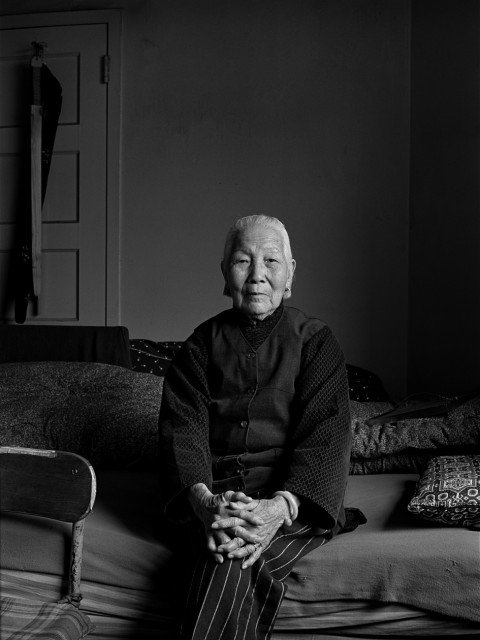
Mrs. Chiu in her apartment, 1981
vvv
A: Some of the people that I photographed were introduced to me through the NYCHP. Others, I met on my own, either walking the streets or hanging out in a particular location. I learned from other documentary photographers and did photos wherever I could, gave copies back to people and then asked to come to their homes. As in anything else, one thing leads to another.
For example I made connections by hanging out at a Senior citizens center with a staff person from the NYCHP. I photographed people and brought back prints as gifts asking if I could photograph them at home. I photographed Mrs. Chiu at the senior citizen’s center and brought her a print. She then let me photograph her at home where I made (#1 on my website). While she didn’t speak English, someone from the Chinatown History Project came with me to translate. Mrs. Chiu had been separated from her husband for many years by discriminatory immigration laws. He died within a few years of her finally being able to immigrate.
I met Mr. Ng (pictures #3 & #4 on my website) on a fieldtrip, organized by the Senior Citizens’ Center, to West Point. He did not speak English but somehow we arranged for me to photograph him where he lived. He lived in what was known as a Bachelor Apartment. (Bachelor Apartments, where groups of men lived together, were one result of anti-Chinese immigration laws. See for example: wikipedia.org/wiki/Chinese_Exclusion_Act. I went to the Bachelor Apartment probably three times on my own. I was not able to communicate very well with him or the other men (except for Mo—photo # 14. Mo did not live there but came occasionally to eat. As I remember it, he explained to me that it was an Ng family Bachelor Apartment. The room off the main room (where Mr. Ng is reading) was ‘rented out’ for social gatherings according to Mo. The four men who lived there ate (at the table in the middle—photos #4, #6 and #7) and slept in the main room. There was basically a bed in each corner along with each man’s belongings (as in #9, #10 and #11). The kitchen (#5 and #8), at the entrance to the apartment, was off the main room. The apartment was on Bayard, between Mott and and Elizabeth St, on the second or third floor at the front of the building.
As an example of one thing leading to another, Mo told me to come to the garment factory where he worked and ask for him. The owner was summoned to the door and was very suspicious but Mo spoke up for me and the owner let me in and allowed me to photograph. I went on my own two or three times. Photos #12, #13, #14 on my website.
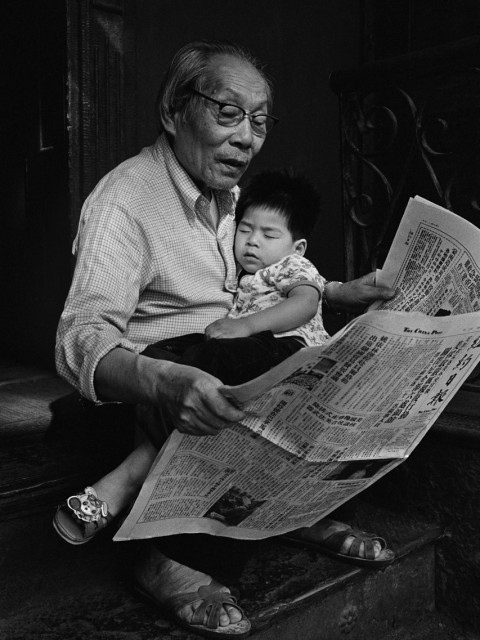
Grandfather with his grandson, Ludlow St., 1983
I have always had a hard time approaching strangers and asking to photograph them and couldn’t speak Chinese. That was a barrier. There were also a lot of tourists, a lot of white people, coming in taking pictures and a lot were obnoxious; even if they weren’t, people don’t often want a stranger sticking a camera in their face. So it’s understandable that I would often get a negative response on the street. At times it was quite discouraging. Other times I would persist.
For example, I was walking on, I think, Ludlow St., and saw the grandfather with his grandson in #45 at the top of a long staircase. I was nervous when I began to photograph from down on the sidewalk. I thought he might not like me photographing (and almost didn’t try) but he looked up at me and smiled which I took as an invitation and walked up the steps and made picture #45. Later I gave him a print and was able to photograph in their apartment.
vvv
Q: What cameras and lenses did you shoot with? Thinking back, do you ever wish you had the technology of today’s digital cameras would of made it any easier when shooting like in difficult lighting situations?
vvv
A: I used four different cameras for this work: Leica M4P, Leitz Minolta CL, Nikon F3 (primarily with 28mm, 35mm and 50mm lenses) and Mamiya 645. Most of what is here is 35mm and the majority was shot with the Leica. Later on I found that I was more comfortable with the Nikon SLR, because I felt that I could see better what I was getting (only my subjective opinion). Almost everything was shot on Tri-X and developed in D-76.
Of course most of the work would have been easier with today’s digital technology. Being able to shoot at much higher ISO would have helped in almost every situation but most obviously in dimly lit interiors.
Being able to see instantly what I got would have made most situations easier. However, one drawback to seeing instant results is that I may think I have what I want when I only have what I think I want so I don’t keep pushing and stop too soon, thereby missing those spontaneous things that happen when least expected. So I may miss what I couldn’t anticipate.
vvv
Q: You put a lot of time into this project. Now 30 years have passed and you are finally getting lots of press. Ever going to revisit Chinatown?
vvv
A: For now, I’m revisiting the work that I did 30 years ago. There is a lot to do. This work on the Chinatown photos is far from finished. There are 45 photos on my website. I’ve only begun to look at about half of what I shot. (My process: I scan on a flatbed scanner each roll of film, making a digital proof sheet which is much easier to look at on a monitor than using a loupe. After studying the digital proofs I select negs to scan with an Imacon scanner with Gerard Franciosa at My Own Color Lab in NYC, a fantastic resource for photographers. I also make my large prints with Gerard. There is a lot more to look at and a lot more to scan and print.)
This work sat in boxes in my closet for years. I don’t want if to disappear. I want to get it out of my closet and in front of people as an exhibition and book. I feel that I have a responsibility to myself, the work, the individuals who opened up to me, the Chinatown community and to history itself.
I currently do not have plans to do more photography in Chinatown but that could change.
vvv
Q: Which photographers have and still do inspire you?
vvv
A: There are many photographers who have and do inspire me. Too many to name. To name any leaves out vast number. But a few that come to mind immediately (in no particular order): Paul Strand, Joseph Koudelka, Eugene Smith, Eugene Richards, Sally Mann, Henri Cartier-Bresson, Alex Webb, James Nachtway, Walker Evans, and on and on and on.
vvv
Q: What more can we expect to see from your photography in the future?
vvv
A: I’ll let you know when I know.
vvv
This interview was conducted via email in June 2015.
New York Chinatown (1981-1984)
vvv
[layerslider id=”13″]
vvv
“Our photography becomes a part of the history of the community in which we work.”
Documentary Responsibility
by Bud Glick
vvv
When we do documentary photography, we establish a permanent bond with those we photograph and the community in which we work.
When I work on a documentary project, and someone allows me to photograph them, I always bring back a print to give them. This is not unusual, basically standard practice for documentary photography. I recently learned a lesson in how important this practice is and how meaningful it is for the people who allow me into their lives. The day after a story about my Chinatown work ran on Petapixel.com I received an email from a woman who recognized her grandfather in one of the photographs. In addition, many people have tweeted about how the photos remind them of another era in Chinatown. This is all wonderful.
However, even better, the next day I received the following email (everything in blue is verbatim from the email):
“Mr. Glick
Saw your set of photos in the article and I want to thank you for showing them! It sure brings back memories of growing up in Chinatown during the ’80s.
Seeing some relatives and some familiar places/faces really brought a smile to my face! The photo of the gentleman with the cigarette holding the bag of scallops among the totes of fish (Photo #19) was a great uncle of mine. My father (at that time had the grocery store next to the fish shop) gave that business to them when they came to the US. The other showing “Kwong Hoy seafood” was the fish shop whose owner I had called god-father. Tony in his Ramone shirt (Photo #43) is a family friend. And I just saw him a few years ago too! Shared this link on my Facebook page and another friend recognized his mom and grandmother.
Will you be publishing more of your photos? Again, thank you!
Sincerely,
Freeman Wong
PS. wanted to share a photo with you of my younger brother, my father and me. This might have been 1981-1982 in front of the grocery store which was next to the fish shop on the corner of Henry and Catherine Streets”
vvvv
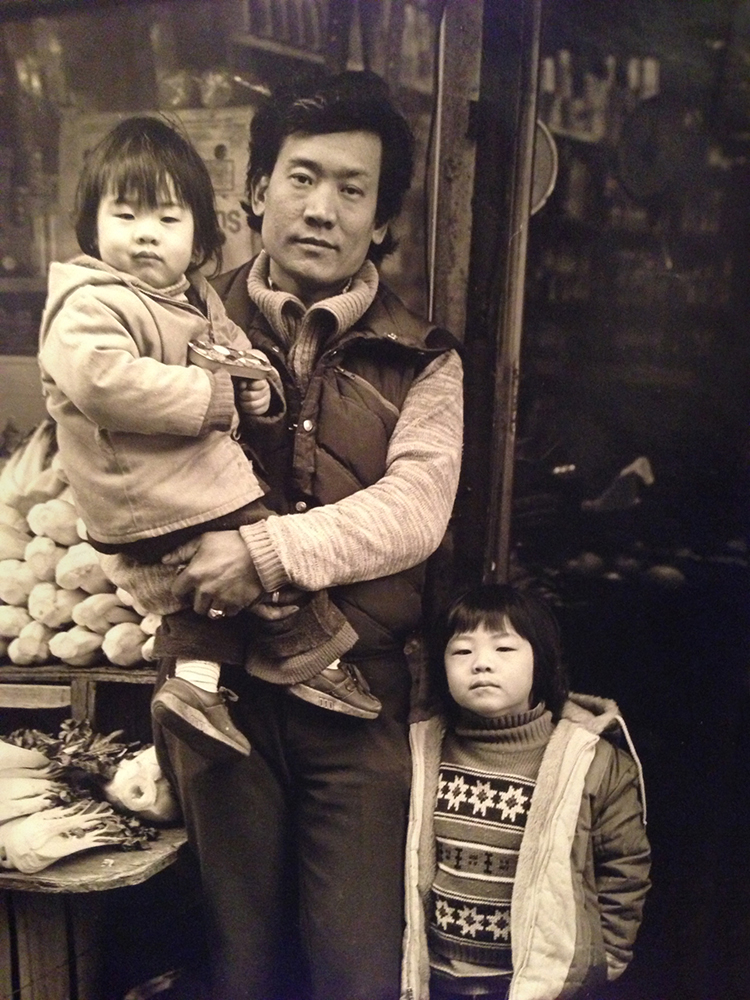
The picture he attached was a photo that I took on the fourth roll of film that I shot at the beginning of the project. (The negative of that photo was destroyed in a fire at the NYCHP so Freeman has the only print – Freeman was not yet 5 years old when I took the picture. He had no idea that I was the photographer. (His father, Frankie, was a great guy who always had a smile, a joke and something for me to eat when I was around. After completing the project I lost touch and Frankie died in 1987.) I emailed Freeman a scan of the proof sheet with the photo and some other photos of his mom with his brother, which he shared with his mom. I also let him know that the photo was from January or February of 1981. He wrote me back:
“Bud,
let me just say that my jaw just dropped to the floor! Now we know you are the one that took those pictures!
Showed them to my mom just now and we both had a tear in our eyes. I will call you later on in the afternoon when I get a chance. Thank you!
Regards,
Freeman”
vvv
Later that day we spoke. Very emotional. Freeman is now 38 (older than his dad was when I took the picture), has three kids, and he and his brother are partners in a seafood business in Chinatown. We met a few months ago.
Freeman’s response has deepened my understanding of the project.
…………….
When we do documentary photography we often see the photographs that we give back as simply a means to an end. However those give back photos become part of a family’s personal history. Years later they will remember their loved ones (and even themselves at a younger age) through the photos that we give back. Freeman showed me his iPhone. The wallpaper is the photo that I took 34 years ago.
I first began scanning and printing the Chinatown work four years ago out of a sense of my own mortality. The work sat in boxes in my closet for years. I didn’t want it to disappear. I wanted to get it out of my closet and in front of people as an exhibit or book. I felt that I had a responsibility to myself and to the work.
With the response that I’ve gotten from the web I’ve been reminded of the importance of my responsibility to the individuals who opened up to me, the Chinatown community and to history itself.
Giving the work back as an exhibit and book will help fulfill the responsibility to myself and my work, the Chinatown community and the people who trusted me with their image.
Our photography becomes a part of the history of the community in which we work.
vvv
Visit: Museum of Chinese in America at www.mocanyc.org
See more of Glick’s photographs at budglickphoto.com
All photos ©Bud Glick Used with permission.
vvv
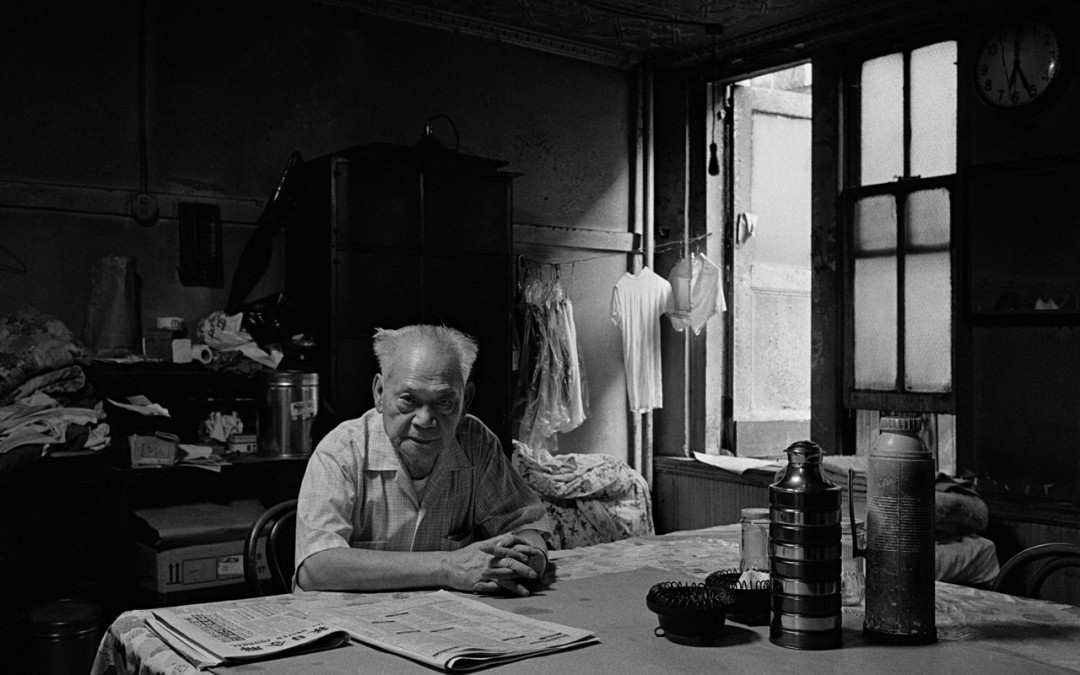
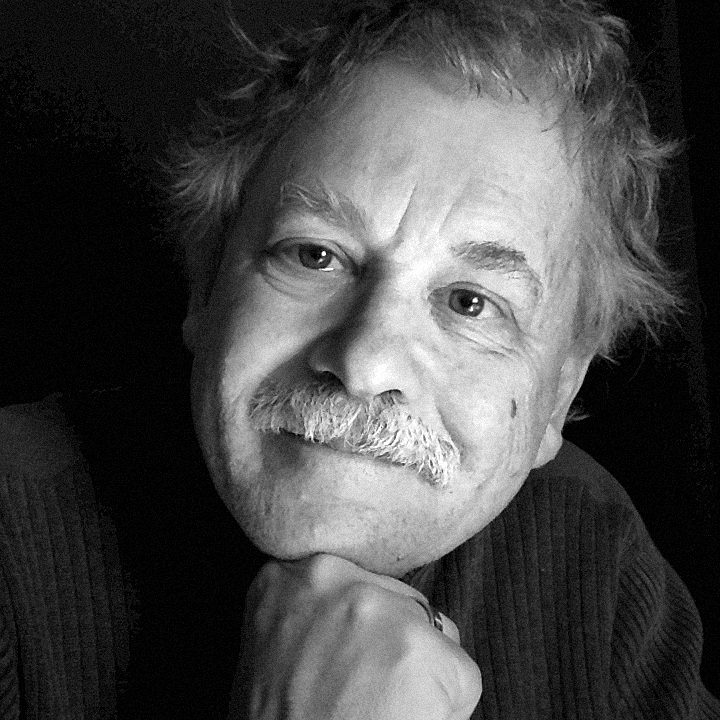
Fantastic photographs that capture the spirit and mood of the Chinatown immigrant families. Wonderful article that provides a human context for understanding the photographer’s perspective, both when he took the images and now in retrospect. The incredible anecdote about Freeman Wong is powerful and definitely stranger than fiction. Thanks for making this treasure trove of Chinatown images available.